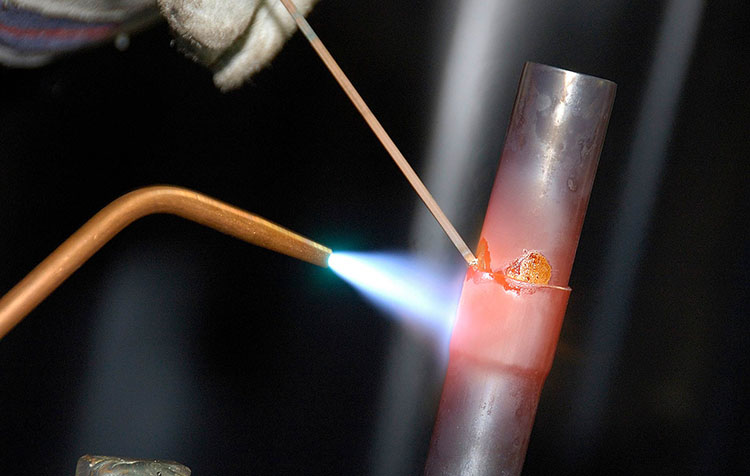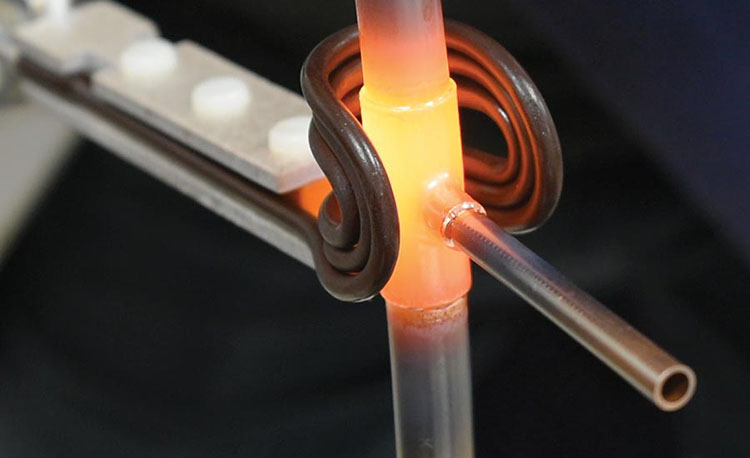The energy source of brazing can be chemical reaction heat or indirect heat energy. It uses a metal with a melting point lower than that of the material to be welded as the solder. After heating, the solder melts, and the capillary action pushes the solder into the gap between the contact surfaces of the joint to wet the surface of the metal to be welded so that the liquid phase and the solid phase are separated. Interdiffusion between the phases to form a brazed joint. Therefore, brazing is a solid-phase and liquid-phase welding method.
1. The characteristics and application of brazing
Brazing uses an alloy with a melting point lower than that of the base metal as the solder. When heated, the solder melts and fills and remains in the joint gap by wetting and capillary action, while the base metal is in a solid state, relying on liquid solder and solid base Interdiffusion between materials forms a brazed joint. Brazing has little effect on the physical and chemical properties of the base metal, less welding stress and deformation, can weld dissimilar metals with large differences in properties, can complete multiple welds at the same time, the appearance of the joint is beautiful and tidy, the equipment is simple, and the production investment is small. However, the brazed joint has low strength and poor heat resistance.
Applications: Carbide cutting tools, drilling bits, bicycle frames, heat exchangers, conduits and various containers, etc.; in the manufacture of microwave waveguides, electron tubes and electronic vacuum devices, brazing is even the only possible connection method.
2.Brazing metal and flux
Brazing filler metal is the filler metal that forms the brazing head, and the quality of the brazing head depends on the brazing filler metal to a large extent. The filler metal should have a suitable melting point, good wettability and caulking ability, can be diffused with the base metal, and should have certain mechanical properties and physical and chemical properties to meet the performance requirements of the joint. According to the different melting point of brazing filler metal, brazing can be divided into two categories: soft brazing and hard brazing.
(1) Soft brazing. Brazing with a melting point below 450 ° C is called soft brazing, and the commonly used brazing filler metal is tin lead brazing, which has good wettability and electrical conductivity and is widely used in electronic products, motor appliances and auto parts. The strength of the brazed joint is generally 60 ~ 140MPa.
(2) Brazing. Brazing with a melting point higher than 450 ° C is called brazing, and common brazing materials are brass and silver base brazing materials. The joint with silver base filler metal has high strength, electrical conductivity and corrosion resistance, the melting point of the filler metal is low, and the process is good, but the price of the filler metal is high, and it is mostly used for welding parts with higher requirements. Brazing is mostly used for steel and copper alloy workpieces with large forces, and for brazing tools. Brazed joint strength of 200 ~ 490MPa,
Note: The contact surface of the base material should be very clean, so the flux should be used. The role of the flux is to remove the oxide and oil impurities on the surface of the base metal and the filler metal, protect the contact surface of the filler metal and the base metal from oxidation, and increase the wettability and capillary fluidity of the filler metal. The melting point of the flux should be lower than that of the filler metal, and the corrosion of the flux residue to the base metal and joints should be less. The common brazing flux is rosin or zinc chloride solution, and the common brazing flux is a mixture of borax, boric acid and alkaline fluoride.
According to different heat sources or heating methods brazing can be divided into: flame brazing, induction brazing, furnace brazing, dip brazing, resistance brazing and so on. Because the heating temperature is relatively low during brazing, it has less influence on the performance of the workpiece material, and the stress deformation of the weldment is also small. However, the strength of the brazed joint is generally low, and the heat resistance is poor.
Brazing heating method: Almost all heating sources can be used as brazing heat sources, and according to this brazing is classified.
Flame brazing: heating with gas flame, used for carbon steel, stainless steel, carbide, cast iron, copper and copper alloys, aluminum and aluminum alloy brazing.
Induction brazing: The use of alternating magnetic fields to generate an induced current in the part of the resistance heat heating welding, for a symmetrical shape of the welding, especially the brazing of pipe shaft.
Dip brazing: the welding part is partially or completely immersed in the molten salt mixture or solder melt, relying on the heat of these liquid media to achieve brazing process, which is characterized by rapid heating, uniform temperature, small deformation of the welding part.
Furnace brazing: The welds are heated by a resistance furnace, which can protect the welds by vacuuming or using reducing or inert gases.
In addition, there are soldering iron brazing, resistance brazing, diffusion brazing, infrared brazing, reaction brazing, electron beam brazing, laser brazing, etc.
Brazing can be used to weld carbon steel, stainless steel, superalloy, aluminum, copper and other metal materials, and can also connect dissimilar metals, metals and non-metals. Suitable for welding joints with small load or working at room temperature, especially suitable for precision, micro and complex multi-brazed welds.
Post time: Jul-06-2023


